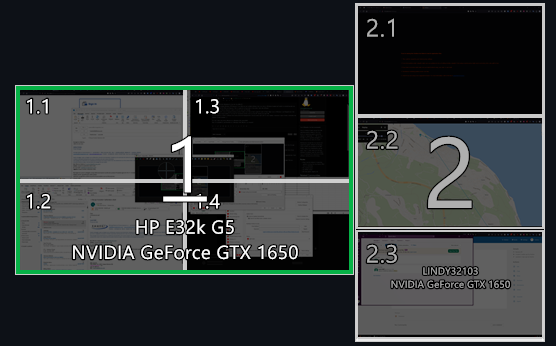I want to switch from Windows to Linux for my office PC.
I will be using multiple Windows VM because in the office we use multiple software that runs only on Windows (maybe we’ll switch to something else, but right now I need the VMs) and because i like to snapshots and go back in time when I test new software.
I thought about Ubuntu because it seems to be the most user friendly.
I always work with a tons of opened windows (mainly Firefox) and I like to have a place for each of them, Right now on Windows I use DisplayFusion that creates multiple virtual screens (7, 4 or the 32" horizontal monitor and 3 on the 28" vertical one, both 4K), I’ve attached the configuration.
So, the question: is there a software that works kinda like DisplayFusion? (virtual screen each with it’s own taskbar, maximize in each of them, remember the position of each window, …).
P.s. Can I pass only some USB port to a Windows VM using KVM?
Pp.s. Is it possible to use Premiere on a Windows VM? Would it run smooth?



Like others have said, most of this is possible but might take a bit of work to set up. In other words, you’re doing somewhat complex things on Windows, so it’s going to get a bit complex on Linux.
I’ve done GPU passthrough using 2 graphics cards (RX 580 going to VM and RX 550 staying connected to host) for VMs on my desktop, and it mostly works. I’d recommend this tutorial for getting it set up. I had to adapt it a bit to get my AMD card working, but it got me started. I now pass through my RX 580 to 3 VMs (obviously not at the same time): Windows 10, Windows 7, and a Hackintosh VM. Although you can technically use just 1 card (leaving Linux without graphics as Windows is using the card), I recommend using dual cards. Just make sure you:
Note that GPU passthrough invites a few bugs. You can’t always return the GPU to Linux after turning off the VM, depending on the GPU. (For a while, I got this fixed and could use my card after VM shutdown, but I’ve experienced a regression and haven’t been able to figure out what happened yet). Also, after I’ve run a VM and try to turn off the host, Linux doesn’t shut down clean sometimes and I have to manually press the power button.
As for distros, I actually don’t recommend Ubuntu anymore. I’ve found a severe decline in its performance compared to other distros and its privacy standards. I personally use Debian, but would recommend Pop OS as an easier distro. OpenSUSE and Fedora are good ones as well.
I’m sorry if I dropped a bunch of new terms without explaining them well. Ask me any questions. In return, may I ask what kind of desktop this is? Is it an ATX or ITX form factor or some sort of proprietary small form factor computer by HP or Dell or something that’s going to be miserable to upgrade?